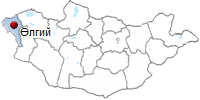Ulgii city. Bayan-Ulgii aimag.
THE REGIONS OF MONGOLIA
BAYAN-ULGII AIMAG.
ULGII

- Territory - 17645 square miles (45,700 sq. km)
- Center - Ulgii town, located 1055 miles
(1,698 km) from Ulaanbaatar.
- Number of somons - 14
- Bayan-Ulgii aimag was established in 1940.
- Population - 100,000.

Called "the Roof of the World", Bayan-Ulgii is a far-off land of high mountains (the Mongol Altai
- Tavan Bogd mountains with 4,373 m peak) torrents and
glaciers, inhabited by Kazakh, a minority who has a different culture from the Mongols, herding yaks and goats and hunting with trained eagles.
Bayan-Ulgii aimag is situated in the extreme West of Mongolia, on the West and North it borders with the Russian Federation and on the South-West with the People's Republic of China.
The Nairamdal peak 14,350 feet (4374 m) of the Altai Tavan Bogd mountain is the highest point,
Khovd, the biggest river
(321 miles /516 km in length) in the country flows through the territory of
the aimag. There are many fresh water lakes in Bayan-Ulgii. Tolbo and Dayan lakes are the largest. This aimag is well-known for
Ak-su, Chigertei and other springs. Every part of Bayan-Ulgii aimag
is suitable for pasture. Rich flora of Bayan-Ulgii includes kobresia, sedge in the mountain plateau, gooseberry and ribes
altissimum, also wild cherry, and sea bucks can be found along the banks of
streams and rivers. 10 percent of the area is forest, consisting mainly of larches. Geological surveys have proved that this territory contains fossils, ferrous and non-ferrous metals, oil and
building material resources. There are wild sheep, ibex, and snow leopards in the Altai high mountain range and marmots, foxes inhabit the lower slopes of mountains. There are bears, lynxes, and
squirrels in the forests. 80 percent of the population is Kazakh and 17 percent is
Uriankhai. In 1998, Bayan-Ulgii aimag harvested over 3.000 tons of grain, 600 tons of forage, and 21.452 tons of
potatoes and vegetables. The coal mine of Bayan-Ulgii aimag produces 404.000 tons of coal and
it's trade turnover is over 166.7 million tugriks.
The Mongol Altai Nuruu is the backbone of Bayan-Olgii. The highest peaks, many over 4000m, are permanently covered with glaciers and snow, while the valleys have a few green pastures, which support about two million livestock, as well as bears, foxes and lynxes. These valleys are dotted with small communities of nomadic families
enjoying the short summer from mid-June to late August, as well as some beautiful alpine lakes.
ULGII
Ulgii (Olgii). Elevation 1710m. Olgii, the capital of the aimag, is an ethnically Kazakh city that happens to be in Mongolia. You can certainly feel that you are in a Muslim-influenced Central Asian region, rather than in Mongolia: many places have squat toilets; in the city, there are signs in Arabic and Kazakh Cyrillic; the market, which is called a bazar rather than the Mongolian zakh, sells the odd kebab (shashlyk) and is stocked with goods from Kazakhstan. Olgii is 1645km from Ulaanbaator but only 225km from Russia.
Olgii is suffering from the outflow of Kazakhs to Kazakhstan following the break up of the Soviet Union. Olgii is the only aimag capital to have a serious decline in population: about 9000 Kazakhs left the city in 1992 and 1993. Many have since returned, disillusioned with life in the exSoviet republic and the population is rising once again.
- The aimag museum gives an excellent of overview of Kazakh culture and of the geography of Bayan-Olgii.
The 2nd floor is devoted to history, and the 3rd floor has some interesting
displays.
- Olgii's mosque and madrasah (Islamic place of learning) is worth a quick look, especially on Friday at lunch time when weekly prayers are held, though you may not be allowed inside. The mosque holds the offices of the Islamic Centre of Mongolia. Its unusual angle is due to its orientation to Mecca.
ADDITIONAL INFORMATION:
PAGES OF THE PICTURE ALBUM
Explore Mongolia | Bayan-Ulgii | MNB World
|